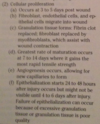06 - disorders of the skin Flashcards
(disorders of the skin)
(wound healing)
- occurs by what two processes?
- regeneration (if partial thickness wound)
(replacement of damaged with normal tissue: heals by migration and proliferation of epidermal cells with little to no inflammation)
- repair (if full-thickness)
(disorders of the skin)
(wound healing)
(repair - full thickness wounds)
- what three phases?
- acute inflammation
- cellular proliferation
- remodeling
(disorders of the skin)
(wound healing)
(repair - full thickness wounds)
- what occurs in acute inflammation phase (first phase)?
- vasoconstriction followed by vasodilation -> clot formation -> leukocytes recruited
(disorders of the skin)
(wound healing)
(repair - full thickness wounds)
- what happens in cell proliferation stage (stage 2)?
- occurs day 3-5

(disorders of the skin)
(wound healing)
(repair - full thickness wounds)
- what happens during remodeling phase (phase 3)?
a. wound contraction occurs (via myofibroblast)

(disorders of the skin)
(factors influencing wound healing)
- what macronutrient important to wound healing?
- is healing better above or below distal limb?
- vitamins and minerals
- are NSAIDs good?
- are corticosteroids good?
- are bandages good?
- proteins
- above
(why worse distal: less blood, thicker epidermis, ^motion, ^ contamination, poor contraction)
- controversial: inflam important for repair - but may be helpful for chronic non-healing wounds
- no - will retard wound repair (should use in wounds with chronic proliferative granulation tissue though)
- keep wound clean - but may result in excessive granulation tissue
(disorders of the skin)
(skin grafts)
name the graft
- from same individual
- from different individual, same species
- from diff species
- autograft
- allograft
- xenograft
(disorders of the skin)
(skin grafts)
(thickness)
1.

(disorders of the skin)
(skin grafts)
(physiology of graft acceptance)
1-3. 3 requirements for healthy graft?
- no infection
- healthy granulation tissue
- good vascular supply
(disorders of the skin)
(skin grafts)
1-4. what are the four phases of graft acceptance?
- serum imbibition (0-48 hours)
- revascularization (inosculation (connect with existing vessels) and neovascularization)
- organization (days 4-8): gaft-host connection established by infiltration of fibrin
- contraction: shrinkage of graft (full thickness shrinks more)
(disorders of the skin)
(skin grafts)
- reasons for graft failure?

(disorders of the skin)
(skin grafts)
- aftercare of post-graft placement?

(disorders of the skin)
(sarcoids)
- most common skin tumor of horses, donkeys, mules
- metastatic?
locally invasive?
- most common in what breeds?
- cause unknown - suspect what plays a role though?
- usually not
yes
- appaloosa and arabian
- bovine papillomavirus
(disorders of the skin)
(sarcoids)
- what are the four forms of sarcoid?

(disorders of the skin)
(sarcoids)
- lesions can occur anywhere - where most common?
- limbs, ventral abdomen, periocular, and ears
(disorders of the skin)
(sarcoids)
- dx?

(disorders of the skin)
(sarcoids)
- tx?


(disorders of the skin)
(sarcoids)
- prognosis?

(disorders of the skin)
(SCC)
- second most common skin tumor in horses, donkeys, and mules
- mets?
locally invasive?
- what breed most common?
- lesions begin as slightly raised, ulcerative lesion and progress to proliferative ulcerative lesions
- common sites?
- slow to mets (usually occur in local LN)
yes
- light-color breeds (appaloosa most common)
- face (eyes, sinus), penis, prepuce, vulva
(disorders of the skin)
(SCC)
- dx?

(disorders of the skin)
(SCC)
- tx?

(disorders of the skin)
(SCC)
- prog?

(disorders of the skin)
(melanoma)
- most common in what horses?
- usually > 6
- common sites (usually multiple tumors)
- mets?
- gray or white horses
(up to 80% of gray horses will have a melanoma by age of 15 years)
- underside of root of tail, perianal-perineal (less freq: eye, abdomen, thorax)
- uncommon

(disorders of the skin)
(melanoma)
- dx based on what?
- histo

(disorders of the skin)
(melanoma)
- tx?

(disorders of the skin)
(melanoma)
- prog?



